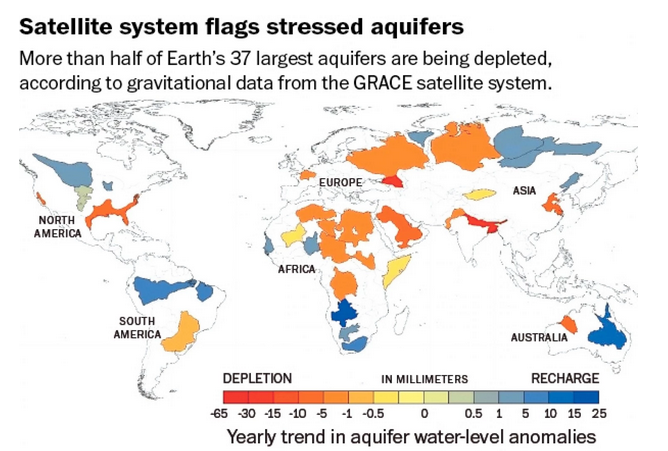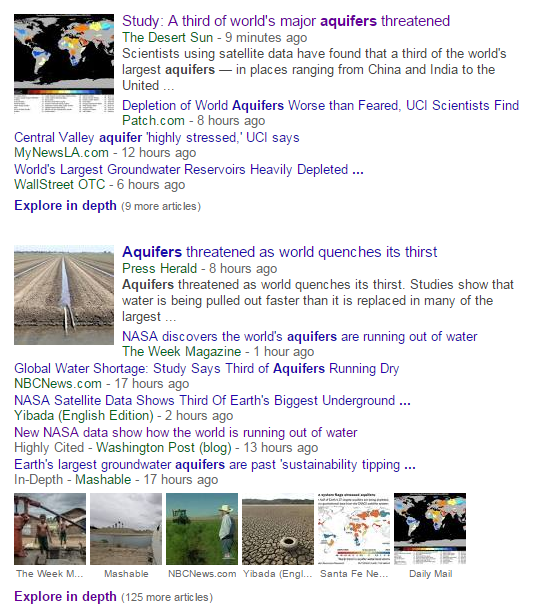Aquifers
https://en.wikipedia.org/?title=Aquifer
○ ○ ○ ○ ○ ○ ○ ○ ○ ○ ○ ○ ○ ○
Water Resources Research
"Quantifying renewable groundwater stress with GRACE", 16 June 2015
http://onlinelibrary.wiley.com/doi/10.1002/2015WR017349/abstract
○ ○ ○ ○ ○ ○ ○ ○ ○ ○ ○ ○ ○ ○ ○ ○ ○ ○ ○ ○ ○ ○ ○ ○ ○ ○ ○ ○ ○ ○
The world’s largest underground aquifers – a source of fresh water for hundreds of millions of people — are being depleted at alarming rates, according to new NASA satellite data that provides the most detailed picture yet of vital water reserves hidden under the Earth’s surface.
Twenty-one of the world’s 37 largest aquifers — in locations from India and China to the United States and France — have passed their sustainability tipping points, meaning more water was removed than replaced during the decade-long study period, researchers announced Tuesday. Thirteen aquifers declined at rates that put them into the most troubled category. The researchers said this indicated a long-term problem that’s likely to worsen as reliance on aquifers grows.
Scientists had long suspected that humans were taxing the world’s underground water supply, but the NASA data was the first detailed assessment to demonstrate that major aquifers were indeed struggling to keep pace with demands...
“The situation is quite critical,” said Jay Famiglietti, senior water scientist at NASA’s Jet Propulsion Laboratory in California and principal investigator of the University of California Irvine-led studies.
Underground aquifers supply 35 percent of the water used by humans worldwide...
The researchers used NASA’s GRACE satellites to take precise measurements of the world’s groundwater aquifers. The satellites detected subtle changes in the Earth’s gravitational pull, noting where the heavier weight of water exerted a greater pull on the orbiting spacecraft. Slight changes in aquifer water levels were charted over a decade, from 2003 to 2013.
“This has really been our first chance to see how these large reservoirs change over time,” said Gordon Grant, a research hydrologist at Oregon State University, who was not involved in the studies...
○ ○ ○ ○
Many previous studies of groundwater storage relied on statistical calculations and looked mostly at how much water was being pumped from the ground. These limited estimates were too uncertain to improve groundwater management, researchers said. For example, past storage estimates for the Northwest Sahara Aquifer System ranged from 10 to 21,000 years.
"This work clearly demonstrates that it is no longer adequate to continue citing decades-old … estimates of total groundwater storage," according to the new studies, which were published in the journal Water Resources Research.
Richey's studies use 11 years of data from NASA satellites and include a number of other factors, such as population, climate and how people use water.
The twin satellites — known as Gravity Recover and Climate Experiment, or GRACE, satellites — orbit the Earth and measure the gravitational pull of water over time. The difference in measurements over time shows how much water the aquifers are gaining or losing...

